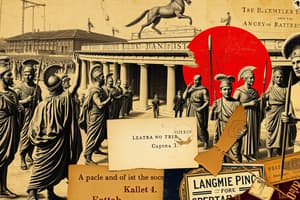Podcast
Questions and Answers
What is a social pyramid?
What is a social pyramid?
- A social event
- A shape used in geometry
- A type of food
- A pyramid outline showing the positions of social classes according to their status in a society (correct)
What is a social class?
What is a social class?
A group in a society that is ranked by factors such as wealth, property, and rights.
What does status mean?
What does status mean?
Importance
Define noble.
Define noble.
What is a peasant?
What is a peasant?
What is the meaning of afterlife?
What is the meaning of afterlife?
What is a hieroglyph?
What is a hieroglyph?
What is Meroe?
What is Meroe?
Define dynasty.
Define dynasty.
What is a kandake?
What is a kandake?
Write a sentence with status.
Write a sentence with status.
Write a sentence with afterlife.
Write a sentence with afterlife.
Write a sentence with dynasty.
Write a sentence with dynasty.
How did location and natural resources help Kush?
How did location and natural resources help Kush?
What did Kush trade with its neighbor, Egypt?
What did Kush trade with its neighbor, Egypt?
Identify the social class in ancient Egypt that belongs on each level of the social pyramid.
Identify the social class in ancient Egypt that belongs on each level of the social pyramid.
Why do you think that the social pyramid in ancient Egypt was rigid?
Why do you think that the social pyramid in ancient Egypt was rigid?
Did everyone in Egyptian society take part in the Opet Festival?
Did everyone in Egyptian society take part in the Opet Festival?
Compare the social pyramid of ancient Egypt with your school's social pyramid.
Compare the social pyramid of ancient Egypt with your school's social pyramid.
In what ways did location influence Kush during this time period?
In what ways did location influence Kush during this time period?
What is one important fact about scribe schools and the types of work they did?
What is one important fact about scribe schools and the types of work they did?
Why was ancient Egyptian society structured like a pyramid?
Why was ancient Egyptian society structured like a pyramid?
What is one important fact about the work of peasants during the flooding season?
What is one important fact about the work of peasants during the flooding season?
Which country is the largest island in the Caribbean Sea?
Which country is the largest island in the Caribbean Sea?
Which South American country is the only one that borders both the Caribbean Sea and the Pacific Ocean?
Which South American country is the only one that borders both the Caribbean Sea and the Pacific Ocean?
Why did it take so long to become a scribe?
Why did it take so long to become a scribe?
How did Egypt's upper class treat artisans?
How did Egypt's upper class treat artisans?
What is a sarcophagus?
What is a sarcophagus?
Why did Egyptian priests embalm bodies?
Why did Egyptian priests embalm bodies?
What does the social pyramid show about Egypt's social classes?
What does the social pyramid show about Egypt's social classes?
What route might a peasant take to raise their social status?
What route might a peasant take to raise their social status?
What does the term hieroglyph refer to?
What does the term hieroglyph refer to?
Flashcards are hidden until you start studying
Study Notes
Social Structure in Ancient Societies
- Social Pyramid: Visual representation of social classes ranked by status, demonstrating the hierarchical structure of society.
- Social Class: Groups within society defined by wealth, property ownership, and rights, establishing both privileges and responsibilities.
- Status: Represents the importance or prestige associated with a person's position in society.
Key Social Roles and Terms
- Noble: Individuals of high birth or rank, often holding significant power in society.
- Peasant: Laborers who performed farming for wealthy landowners, forming the lower class in the social hierarchy.
- Dynasty: A lineage or family ruling over generations, significantly impacting political stability and cultural continuity.
Cultural Beliefs and Practices
- Afterlife: The belief in existence following death; vital in ancient Egyptian culture influencing burial practices and rituals.
- Hieroglyph: A symbol from the writing system developed around 3000 B.C.E., indicating the complexity and sophistication of early writing.
Important Locations and Trade
- Meroe: A pivotal city on the Nile River renowned for being a center of Kushite culture and industrial activity.
- Kush's Trade Relations: Engaged in trade with Egypt, exchanging gold, ivory, and timber for grain and linen, showcasing economic interdependence.
Social Pyramid of Ancient Egypt
- Top Level: Pharaoh, representing absolute power.
- Upper Levels: Government officials, and priests held important administrative and religious roles.
- Middle Levels: Scribes and artisans provided necessary services and crafts.
- Lower Level: Peasants comprised the largest class, performing essential agricultural work.
Social Mobility and Structure
- Rigid Social Pyramid: Limited movement between classes, often determined by family lineage and occupation, especially affecting children who inherited their parents' roles.
- Becoming a Scribe: Challenging education process due to the complexity of hieroglyphics, with scribes holding elevated status due to their literacy.
Cultural Festivals and Community Involvement
- Opet Festival: A major religious event in which nearly all societal members participated, demonstrating community engagement in cultural practices.
Embalming and Burial Practices
- Embalming Purpose: Performed by priests to prepare bodies for the afterlife, reflecting the significance of preserving the physical form for spiritual continuity.
Comparisons and Contextual Connections
- Social Pyramid Analogy: Comparison of ancient Egyptian social structure to a modern school's hierarchy, illustrating similarities in authority and roles.
Miscellaneous Facts
- Sarcophagus: A large stone coffin used in ancient Egyptian burial practices, emphasizing the importance of preservation and respect for the deceased.
- Geographic Insights:
- Cuba: Largest island in the Caribbean Sea.
- Colombia: Unique South American country bordered by both Caribbean Sea and Pacific Ocean.
Summary of Key Concepts
- Importance of Hierarchy: In ancient Egypt, a pyramid structure highlighted that fewer people occupied higher social classes, which also held more significant power and influence within society.
- Peasant Labor: During flooding season, peasants contributed to royal projects, showcasing their essential role in maintaining the kingdom's infrastructure.
Studying That Suits You
Use AI to generate personalized quizzes and flashcards to suit your learning preferences.



